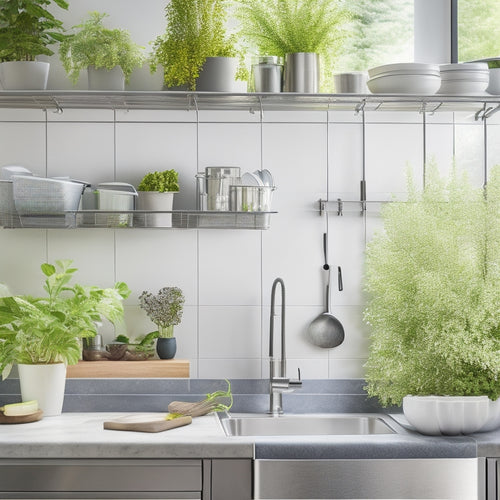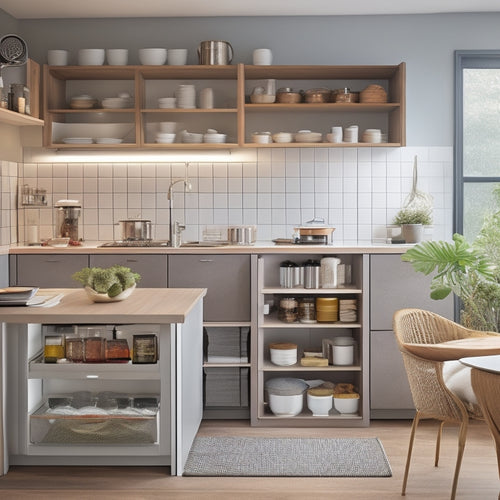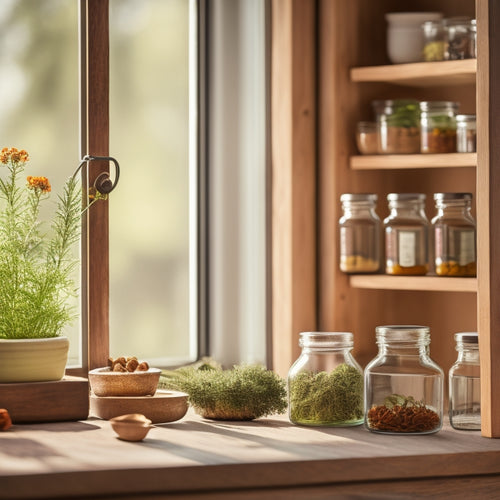
Revolutionizing Food Storage: Tips and Benefits
Share
Effective food storage is essential for a functional and safe kitchen environment, greatly impacting food freshness, quality, and safety. Optimizing storage space through innovative organization strategies, utilization of vertical space, and categorization can reduce food spoilage and promote healthier storage. Selecting eco-friendly storage options like glass containers offers durability, safety, and recyclability. Implementing proper storage practices, food rotation strategies, and proper cleaning techniques can extend shelf life and prevent cross-contamination. By adopting these techniques, individuals can revolutionize their food storage and open up a world of benefits - discover how to elevate your food storage to the next level.
Key Takeaways
• Implement space-saving solutions and creative organization strategies to maximize storage capacity and reduce food waste.
• Choose eco-friendly glass containers for safe, non-porous, and durable food storage that can be reheated without absorbing odors.
• Use categorization and grouping techniques to efficiently store similar items, promoting a more functional and safe kitchen environment.
• Employ food rotation strategies and store high-risk foods refrigerated below 40°F to extend shelf life and prevent spoilage.
• Practice proper cleaning techniques to prevent cross-contamination and ensure a safe and healthy food storage environment.
Optimizing Your Food Storage Space
Efficiently allocating space for food storage is an essential aspect of maintaining a well-organized kitchen, as it directly impacts the accessibility and visibility of ingredients, ultimately influencing meal preparation and planning.
Implementing space saving solutions and creative organization strategies can greatly optimize storage capacity. By utilizing vertical space, corner shelves, and adjustable shelving, homeowners can maximize storage capacity while maintaining easy access to essential items.
Efficient storage techniques, such as categorizing and grouping similar items, can further streamline the storage process. By adopting these strategies, individuals can create a more functional and safe kitchen environment, reducing the risk of food spoilage and promoting a healthier food storage experience.
Selecting the Right Storage Options
When it comes to selecting the right storage options, homeowners must consider the specific needs of their kitchen, including the types of food being stored, the available space, and personal preferences for material and design.
Choosing eco-friendly options, such as glass containers, is a great way to reduce waste and minimize environmental impact. The benefits of glass containers are numerous, including their durability, non-porous surface, and ease of recycling. Additionally, glass containers are safe for reheating and do not absorb odors, making them an ideal choice for food storage.
Maximizing Food Freshness and Safety
By utilizing a combination of effective food storage techniques and selecting the right storage options, homeowners can extend the shelf life of their food while maintaining its freshness and safety. To maximize food freshness and safety, it is essential to implement proper food storage practices.
This includes implementing food rotation strategies to guarantee older items are consumed before they expire. Using proper cleaning techniques to prevent cross-contamination and spoilage. Storing raw meat, poultry, and seafood in airtight containers to prevent juices from leaking onto other foods. Keeping high-risk foods, such as dairy and eggs, refrigerated at a temperature below 40°F (4°C).
Labeling and dating stored food to guarantee timely consumption and rotation.
Frequently Asked Questions
Can I Use Food Storage Containers for Hot Foods?
When storing hot foods, select containers with insulated options to maintain temperature and guarantee safety. Additionally, verify microwave safety by checking the container's specifications, as not all materials are suitable for high-temperature use.
Are Glass Containers More Expensive Than Plastic Ones?
Glass containers may be more expensive than plastic ones upfront, but their durability and non-porous nature reduce long-term costs, while also mitigating environmental and health concerns associated with plastic storage options.
How Do I Clean and Maintain My Food Storage Containers?
When cleaning food storage containers, employ gentle scrubbing, mild soap, and warm water to prevent scratches. Dry thoroughly to prevent water spots, and store with lids off to maintain airflow, preventing odor and mold growth.
Can I Use Food Storage Bags for Storing Raw Meat?
When storing raw meat, it's recommended to avoid using food storage bags due to potential cross-contamination risks. Instead, opt for airtight, freezer-safe containers that prevent juices from leaking, ensuring safe storage and minimizing contamination risks.
Are Canisters Suitable for Storing Liquid Ingredients?
Did you know that 40% of liquid ingredients spoil due to improper storage? When storing liquid ingredients, canisters with airtight seals are not ideal, as they can leak or allow air to enter, compromising liquid preservation.
Related Posts
-

Wall-Mounted Dish Drainer Racks for Kitchens
Wall-mounted dish drainer racks are a game changer for your kitchen. They maximize vertical space, freeing up preciou...
-

Space-Saving Kitchen Solutions for Busy Homeowners
To maximize your kitchen's potential, start with vertical storage solutions like wall-mounted shelves and pegboards f...
-

Spice Rack With Integrated Herb Garden
A spice rack with an integrated herb garden alters your kitchen into a culinary haven. You'll have fresh herbs at you...


